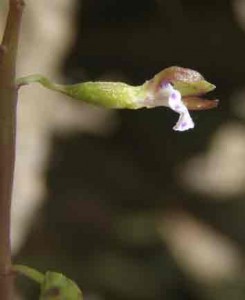You most likely won’t see the little autumn coralroot orchid, Chorallorhiza odontorhiza, on any of your fall woods walks, and with that challenging notion I hope you’ll go out and discover it.
I hadn’t seen one in years – just hadn’t been in the right place at the right time. Walking along a forest trail in an earth sanctuary west of Burlington last week, I was lucky to glance down and spot one on the edge of the path. Stooping down for “a closer look†at that six-inch-high, solitary leafless stem, I discovered that none of the flower buds were open. Happy to have discovered this little orchid again after so many years, my visual awareness was sharpened as I continued along the trail.
Several hundred feet farther along, I paused to examine a fallen former giant of the forest reduced by years of decay to a linear hump of rich organic matter at the trail’s edge. I was surprised to find a cluster of four coralroots. Looking more closely along the entire length, I discovered several more clusters of four-to-eight-inch-high orchid stems and a few more single ones scattered about in the adjacent forest litter. Here’s a suggestion for any of you who may go out in search of this little orchid: Look for fallen trees in advanced stages of decay. These rotting logs seem to provide suitable sites for germination of the talcum powder-like seeds of these small terrestrial orchids. Your only opportunity to find this orchid is now, the few weeks it flowers and develops seed in the early fall.
This leafless orchid is saprophytic, which means it derives nutrients from decaying organic matter. The description in Flora of the Carolinas, Virginia, and Georgia by Alan Weakley is interesting: “The mycotrophic nature of Corallorhiza is well established, but the exact means of the transfer of nutrients from the fungal hyphae to the orchid is not yet understood.â€
Wow, there is a lot going on here. Those orchid roots, shaped somewhat like sea coral, thus coralroot, are apparently inclined to move toward the mycorrhizae, that not-fully-understood association between fungal mycelium, hyphae and the roots of specific plants. Now there’s another potential Ph.D. research project.
Whether or not we fully understand what is going on beneath the surface of the ground, this little orchid is making us aware of the importance of the hidden interactions of nature.
Another observation in Weakley’s Flora is that some of the plants have cleistogamous, closed, flowers and other plants have chasmogamous, open, flowers. So, down on hands and knees with your trusty hand lens, you’ll have to determine which you have. You’ll need a good eye, because those flowers are only an eighth-inch long. I found one reference stating that open and closed flowers occur on separate plants. Curiously, I observed open and closed flowers on some of the same stems. More research needed here!
Having recently seen some of these really obscure coralroot orchids, I’m going out several times during the next couple of weeks in search for more. Hope you’ll do the same.

